
Jan Josephszoon van Goyen was a Dutch landscape painter. The scope of his landscape subjects was very broad as he painted forest landscapes, marine paintings, river landscapes, beach scenes, winter landscapes, cityscapes, architectural views and landscapes with peasants. The list of painters he influenced is much longer. He was an extremely prolific artist who left approximately twelve hundred paintings and more than one thousand drawings.

Printmaking is the process of creating artworks by printing, normally on paper, but also on fabric, wood, metal, and other surfaces. "Traditional printmaking" normally covers only the process of creating prints using a hand processed technique, rather than a photographic reproduction of a visual artwork which would be printed using an electronic machine ; however, there is some cross-over between traditional and digital printmaking, including risograph.

Jean-Auguste-Dominique Ingres was a French Neoclassical painter. Ingres was profoundly influenced by past artistic traditions and aspired to become the guardian of academic orthodoxy against the ascendant Romantic style. Although he considered himself a painter of history in the tradition of Nicolas Poussin and Jacques-Louis David, it is his portraits, both painted and drawn, that are recognized as his greatest legacy. His expressive distortions of form and space made him an important precursor of modern art, influencing Picasso, Matisse and other modernists.
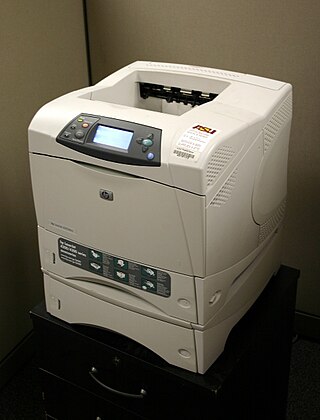
Laser printing is an electrostatic digital printing process. It produces high-quality text and graphics by repeatedly passing a laser beam back and forth over a negatively charged cylinder called a "drum" to define a differentially charged image. The drum then selectively collects electrically charged powdered ink (toner), and transfers the image to paper, which is then heated to permanently fuse the text, imagery, or both, to the paper. As with digital photocopiers, laser printers employ a xerographic printing process. Laser printing differs from traditional xerography as implemented in analog photocopiers in that in the latter, the image is formed by reflecting light off an existing document onto the exposed drum.

Canvas is an extremely durable plain-woven fabric used for making sails, tents, marquees, backpacks, shelters, as a support for oil painting and for other items for which sturdiness is required, as well as in such fashion objects as handbags, electronic device cases, and shoes. It is popularly used by artists as a painting surface, typically stretched across a wooden frame.

Dye-sublimation printing is a term that covers several distinct digital computer printing techniques that involve using heat to transfer dye onto a substrate.

Watercolor or watercolour, also aquarelle, is a painting method in which the paints are made of pigments suspended in a water-based solution. Watercolor refers to both the medium and the resulting artwork. Aquarelles painted with water-soluble colored ink instead of modern water colors are called aquarellum atramento by experts. However, this term has now tended to pass out of use.

William-Adolphe Bouguereau was a French academic painter. In his realistic genre paintings, he used mythological themes, making modern interpretations of classical subjects, with an emphasis on the female human body. During his life, he enjoyed significant popularity in France and the United States, was given numerous official honors, and received top prices for his work. As the quintessential salon painter of his generation, he was reviled by the Impressionist avant-garde. By the early twentieth century, Bouguereau and his art fell out of favor with the public, due in part to changing tastes. In the 1980s, a revival of interest in figure painting led to a rediscovery of Bouguereau and his work. He finished 822 known paintings, but the whereabouts of many are still unknown.
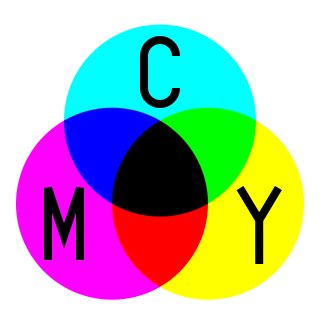
Subtractive color or subtractive color mixing predicts the spectral power distribution of light after it passes through successive layers of partially absorbing media. This idealized model is the essential principle of how dyes and pigments are used in color printing and photography, where the perception of color is elicited after white light passes through microscopic "stacks" of partially absorbing media allowing some wavelengths of light to reach the eye and not others, and also in painting, whether the colors are mixed or applied in successive layers.

Digital printing is a method of printing from a digital-based image directly to a variety of media. It usually refers to professional printing where small-run jobs from desktop publishing and other digital sources are printed using large-format and/or high-volume laser or inkjet printers.

Photogravure is a process for printing photographs, also sometimes used for reproductive intaglio printmaking. It is a photo-mechanical process whereby a copper plate is grained and then coated with a light-sensitive gelatin tissue which had been exposed to a film positive, and then etched, resulting in a high quality intaglio plate that can reproduce detailed continuous tones of a photograph.
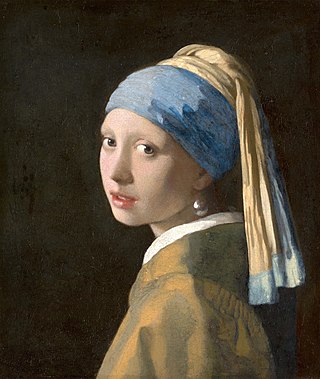
Girl with a Pearl Earring is an oil painting by Dutch Golden Age painter Johannes Vermeer, dated c. 1665. Going by various names over the centuries, it became known by its present title towards the end of the 20th century after the earring worn by the girl portrayed there. The work has been in the collection of the Mauritshuis in The Hague since 1902 and has been the subject of various literary and cinematic treatments.

Printed electronics is a set of printing methods used to create electrical devices on various substrates. Printing typically uses common printing equipment suitable for defining patterns on material, such as screen printing, flexography, gravure, offset lithography, and inkjet. By electronic-industry standards, these are low-cost processes. Electrically functional electronic or optical inks are deposited on the substrate, creating active or passive devices, such as thin film transistors; capacitors; coils; resistors. Some researchers expect printed electronics to facilitate widespread, very low-cost, low-performance electronics for applications such as flexible displays, smart labels, decorative and animated posters, and active clothing that do not require high performance.

A wash is a term for a visual arts technique resulting in a semi-transparent layer of colour. A wash of diluted ink or watercolor paint applied in combination with drawing is called pen and wash, wash drawing, or ink and wash. Normally only one or two colours of wash are used; if more colours are used the result is likely to be classified as a full watercolor painting.
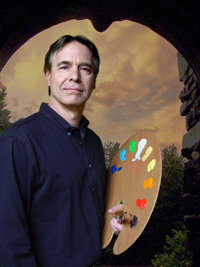
Thomas E. Breitenbach is a self-taught American artist best known for his painting Proverbidioms, a raucous and comical depiction of over 300 common proverbs and clichés. He also collaborated with Jim Morrison of The Doors, shortly before Morrison's 1971 death, on a painting intended for use on his An American Prayer album.

The Guitar Player is an oil painting by Dutch Golden Age artist Johannes Vermeer (1632–1675), dated c. 1672. This work of art is one of Vermeer's final artistic activities, providing insight into the techniques he mastered and approaches to painting he favored. The painting has been on display at Kenwood House, London since the 1920s, as part of the Iveagh Bequest collection. After being recovered from a theft in 1974, when the painting was held for ransom, The Guitar Player was returned to Kenwood House.

Portrait of Madame de Senonnes is an 1816 painting by Jean-Auguste-Dominique Ingres. It shows Madame de Senonnes, née Marie-Genevieve-Marguerite Marcoz, viscountess of Senonnes (1783–1828). Marcoz was 31 when the portrait was completed. Ingres had earlier portrayed her in a drawing of 1813.
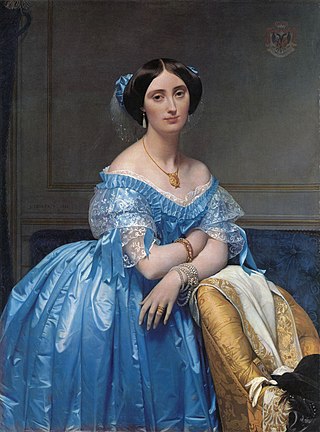
The Princesse de Broglie is an oil-on-canvas painting by the French Neoclassical artist Jean-Auguste-Dominique Ingres. It was painted between 1851 and 1853, and shows Pauline de Broglie, who adopted the courtesy title 'Princesse'. Born Pauline de Galard de Brassac de Béarn, she married Albert de Broglie, the future 28th Prime Minister of France, in 1845. Pauline was 28 at the time of the painting's completion. She was highly intelligent and widely known for her beauty, but she suffered from profound shyness and the painting captures her melancholia. Pauline contracted tuberculosis in her early 30s and died in 1860 aged 35. Although Albert lived until 1901, he was heartbroken and did not remarry.

Self-Portrait at Seventy-Eight is an 1858 oil-on-canvas painting by the French Neoclassical artist Jean-Auguste-Dominique Ingres. It is one of the last of his many portraits, which he had always regarded as bothersome distractions from his true calling, history painting. The painting measures 24 3/8 x 20 1/8 inches and is in the Uffizi Gallery, Florence.
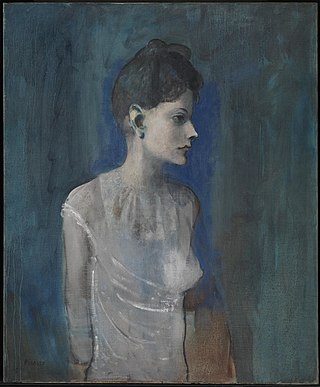
Girl in a Chemise is an oil-on-canvas painting created c. 1905 by Pablo Picasso. It is a portrait of a girl, whom experts believe to be Madeleine, Picasso's girlfriend during this period. Stylistically, the painting belongs to Picasso's Rose Period, although it is predominantly blue in tone. The painting is particularly remarkable for the presence of an earlier portrait of a young boy hidden beneath the surface, which Picasso transformed into the girl by making some subtle changes. The portrait has been housed in the collection of the Tate since 1933.



















